Austal Pushes Big Missiles For Small Ships: LCS & VLS
Posted on
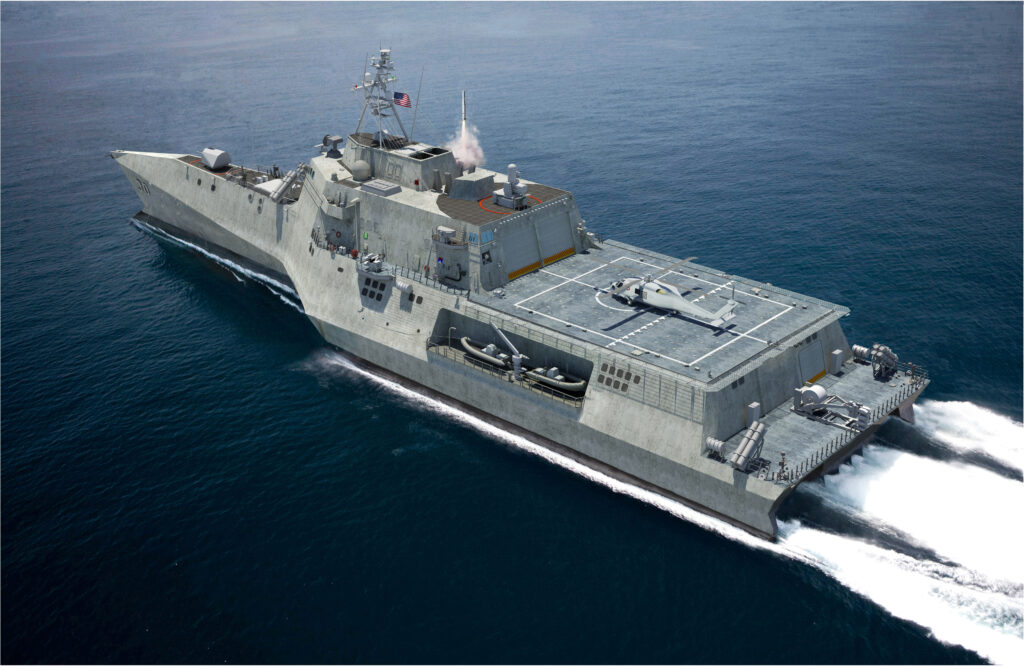
Austal’s proposal for an LCS frigate. Note missile firing from a Vertical Launch System (VLS).
NATIONAL HARBOR: How much firepower can fit on the Navy’s smallest warship? With the Chinese and Russian navies on the rise, American admirals want more “distributed lethality” from everything in the fleet, especially the controversial Littoral Combat Ship. Here at the Navy League’s annual Sea-Air-Space conference, the manufacturers of the two very different versions of LCS have offered very different options to upgun it.
One LCS maker, Australia-based Austal, is offering an upgunned LCS “frigate” equipped with the standard heavy-duty, multi-purpose missile launcher used on cruisers and destroyers, the Mark 41 Vertical Launch System — something the Navy’s frigate study said would be too bulky and costly. Rival LCS builder Lockheed told me it could add VLS to its very different frigate design, but it hasn’t done so because the Navy hasn’t asked. With the official requirements for the frigate still in draft, the Navy has to figure out the trade-off: Is the extra firepower and flexibility VLS provides worth the cost, the weight, and the need to take something else off to make room?
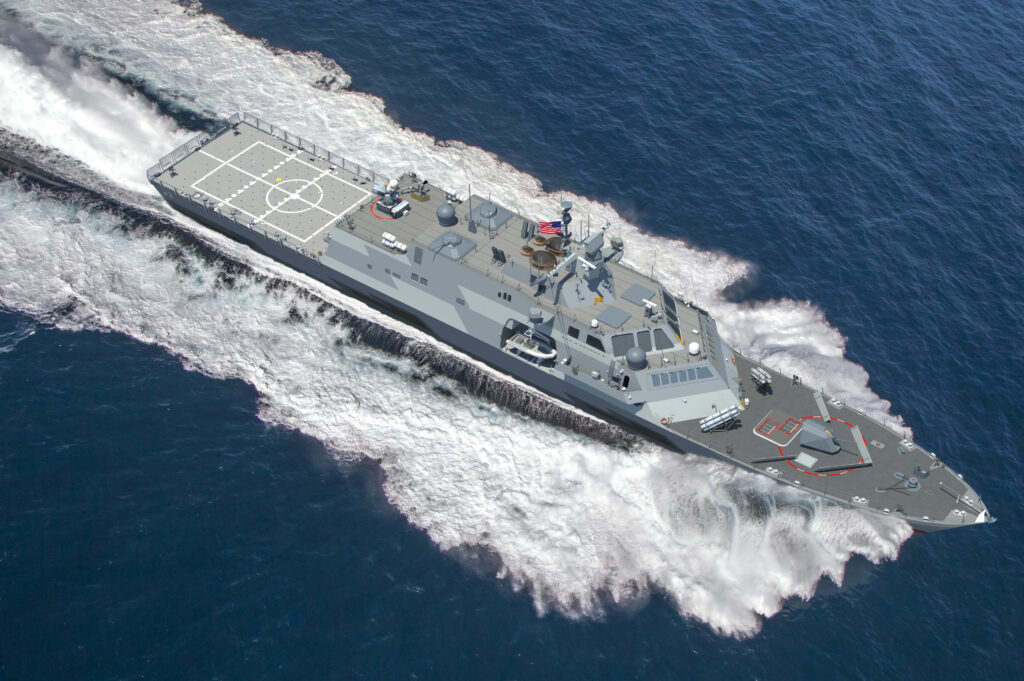
Lockheed’s proposal for an LCS frigate.
Critics have long lambasted LCS for its lack of combat power. While the Lockheed and Austal variants are very different, each has a single 57 millimeter bow gun and two 30 mm autocannon on the sides. All LCS are now being upgraded with the Hellfire missile — famously used by Predator drones and Apache helicopters — but that’s originally an anti-tank weapon and only has a five-mile range. The Navy’s now looking at larger Over The Horizon anti-ship missiles with a hundred-plus-mile range. By contrast, Russian corvettes of just 1,000-2,000 tons displacement — compared to over 3,000 tons for LCS — carry Kalibr cruise missiles that can strike targets in Syria from 900 miles away.
Why does the LCS have so much less firepower than some smaller foreign counterparts? Because it’s designed to do different things. Instead of being a heavily armed but relatively expendable missile boat, LCS is a kind of mini-aircraft carrier meant to carry helicopters, drones, and unmanned watercraft. Its hull is built with a lot of open space for mix-and-match mission packages for various roles: defeating fast attack boats, hunting submarines, or clearing mines. However, heavy firepower to fight enemy fleets just wasn’t a priority back in the 1990s when the LCS was conceived. That has changed.
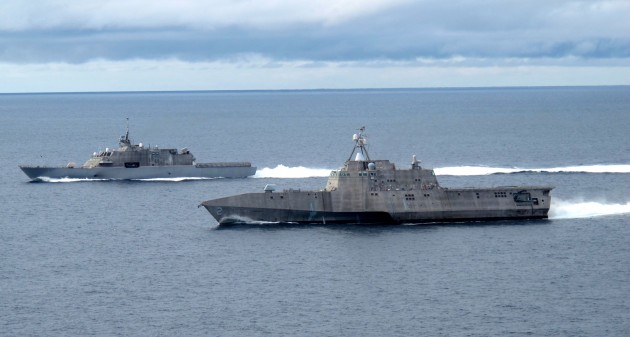
The two variants of the current Littoral Combat Ship, Lockheed’s LCS-1 Freedom (far) and Austal’s LCS-2 Independence (near).
Different Visions
Now that rival fleets are on the rise, the Navy is willing to trade off some of LCS’s multi-mission flex space for more combat power. The Navy’s vision for what it’s now calling a frigate will have built-in weapons and sensors for the anti-ship and anti-submarine warfare missions, but no capacity for minesweeping. It will have the Over The Horizon missile, but it won’t have VLS, which means it can’t carry the Navy’s standard long-range weapons for attacking land targets, hostile ships, or incoming enemy aircraft and missiles. (VLS cells can accommodate 3,000-plus-pound missiles, while the OTH candidates are under 1,000). The lack of VLS on the Navy’s frigate concept severely limits both its offensive firepower and its defensive capability to escort other ships under threat of air or missile attack.
“They did evaluate a Vertical Launch System,” then-Chief of Naval Operations Adm. Jonathan Greenert said when he rolled out the proposal, but it was “kind of heavy, kind of big, a major change [adding] cost, time.”
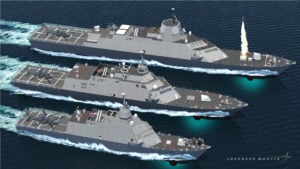
Lockheed has proposed larger variants of the LCS, including ones with VLS, for foreign markets.
Lockheed Martin’s frigate proposal colors carefully within the lines the Navy has laid out. The company told me they could add up to 16 VLS cells to the current LCS hull (or more launchers with a longer hull), and they have offered VLS-equipped variants to foreign customers. But their proposal for the Navy frigate competition doesn’t have a Vertical Launch System. Instead, it retains the current LCS’s 57 mm bow gun and 30 mm autocannons while adding Hellfires and up to 16 Over The Horizon missiles, as well as enhanced sensors, decoys, and electronic warfare equipment. It accommodates a larger crew to operate all this equipment. On the downside, it gives up capacity to launch unmanned watercraft, but it can still carry either two manned MH-60 Sea Hawk helicopters or one MH-60 plus three MQ-8C Fire Scout drones.
Austal’s proposal, by contrast, goes beyond what the Navy asked for. It has the same guns (1×76 mm, 2×30 mm), the same Hellfires, the same 16 Over-The-Horizon missiles, but then it adds 16 Vertical Launch System cells. So what does Austal give up to fit VLS? Primarily flight deck and hangar space: Their frigate can only carry one Sea Hawk helicopter and one Fire Scout. That’s a significant trade-off, since the aircraft play a big role in everything from spotting subs to shooting fast attack boats, clearing mines, and even decoying incoming missiles away from the ship.
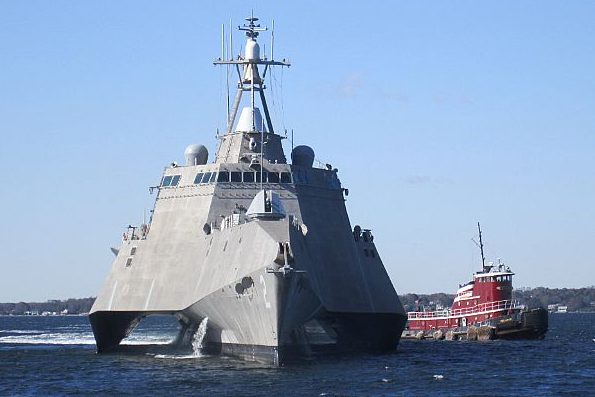
LCS-2, USS Independence, shows off its unique “trimaran” design.
Clark’s Critique
It’s worth noting that Austal’s LCS design, the broad trimaran Independence class, starts out with a much bigger flight deck than Lockheed’s narrower single-hull Freedom class. Both variants meet the Navy’s current requirements for LCS, but they aren’t necessarily equally easy to upgrade to the frigate.
“For the Independence-class LCS, the trimaran design is probably better able to accommodate adding weight in the form of missile launchers higher in the ship,” said Bryan Clark, a retired Navy officer, who’s argued for VLS-equipped LCS in the past. “Compared to the trimaran design, however, it may be easier to increase the Freedom-class’ weight capacity by adding a hull insert to lengthen the ship.”

Bryan Clark
If you don’t make the ship bigger, however, Clark worries that adding both Vertical Launch Systems and Over The Horizon missiles would require taking too many other important systems off. “Based on DOT&E’s testing results and the Navy’s own statements…I believe these additions will consume most of the mission package weight allowance for the ship,” Clark wrote me. “That would probably prevent it from also carrying the ASW (Anti-Submarine Warfare) mission package.” A frigate that can’t hunt subs would be badly handicapped against either the Chinese or the Russian fleet.
(UPDATE: Austal assured me their design carries the full complement of ASW equipment and crew, as well as VLS, and that the broad trimaran hull has plenty of room for all the upgrades).
What’s more, Clark said, adding VLS doesn’t solve all LCS’s problems. “We should also keep in mind that adding the VLS magazine will not address the other limitations of the LCS being used in a frigate role, endurance and manpower,” he said. The LCS is undermanned as is, and each item of equipment you add — including VLS — requires more crew to operate even as it takes away room you could use for more crew.
So what’s the solution? Clark and his colleagues at the Center for Strategic & Budgetary Assessments were commissioned by Congress to come up with an alternative future fleet to the Navy’s official plans. Their “alternative Force Structure Assessment,” lavishly praised by Senate Armed Services chairman (and LCS critic) John McCain, includes a proposal to build an all-new frigate design in the 4,000 to 5,000-ton range, significantly bigger than LCS. That would allow plenty of tonnage for VLS and other weapons.
The Navy, however, argues an all-new design would cost too much and take too long. Right now, the Littoral Combat Ship is the bird in the hand. The question is how sharp they can make its claws.
Updated 3:25 pm with additional detail from Austal.
Subscribe to our newsletter
Promotions, new products and sales. Directly to your inbox.
